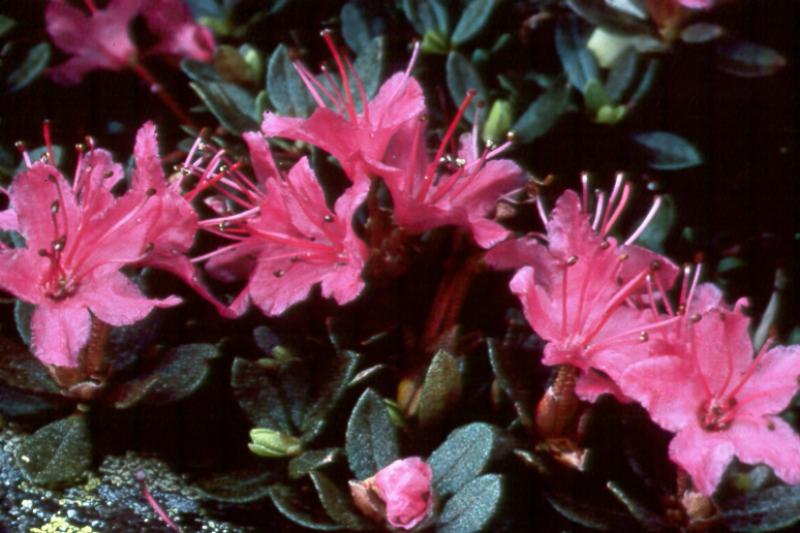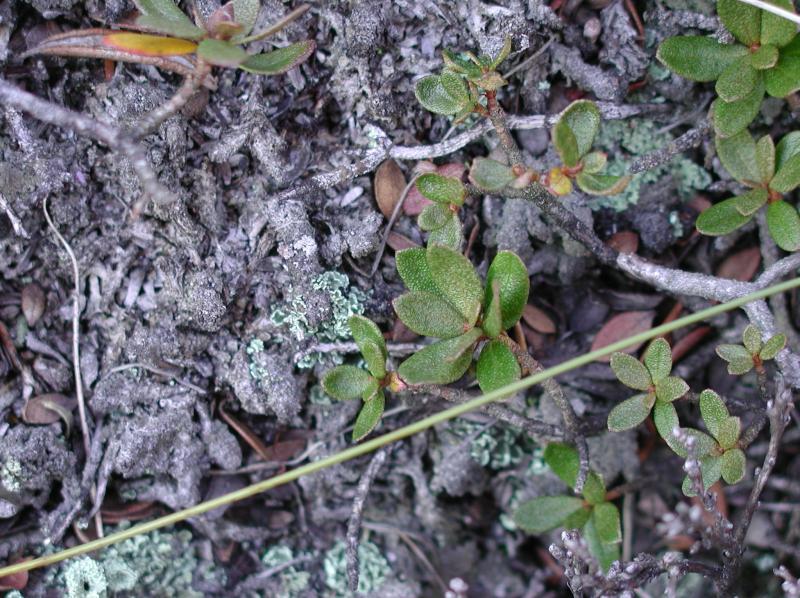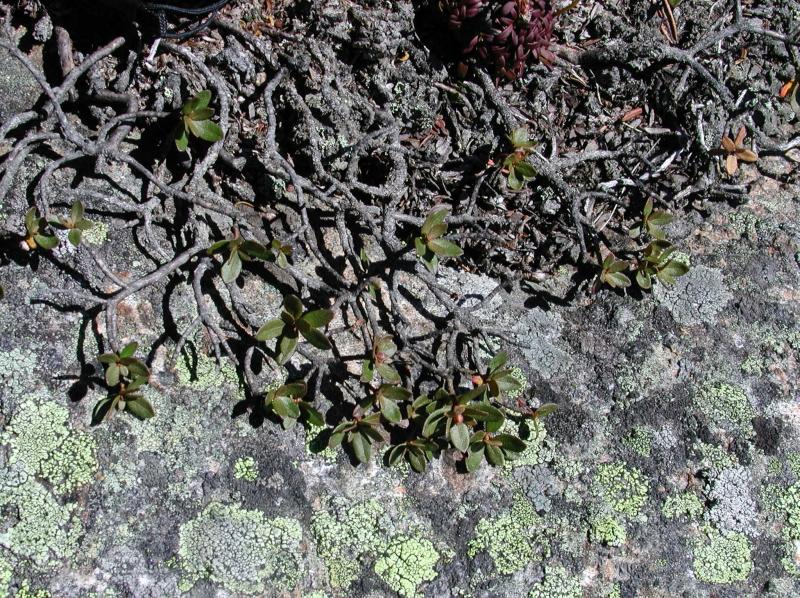Lapland Rosebay
Rhododendron lapponicum var. lapponicum None
- Class
- Dicotyledoneae (Dicots)
- Family
- Ericaceae (Heath Family)
- State Protection
- Endangered
Listed as Endangered by New York State: in imminent danger of extirpation in New York. For animals, taking, importation, transportation, or possession is prohibited, except under license or permit. For plants, removal or damage without the consent of the landowner is prohibited.
- Federal Protection
- Not Listed
- State Conservation Status Rank
- S1
Critically Imperiled in New York - Especially vulnerable to disappearing from New York due to extreme rarity or other factors; typically 5 or fewer populations or locations in New York, very few individuals, very restricted range, very few remaining acres (or miles of stream), and/or very steep declines.
- Global Conservation Status Rank
- G5T5?
Secure globally (most likely) - Conservation status of the subspecies/variety is uncertain, but is most likely common in the world; widespread and abundant (but may be rare in some parts of its range). More information is needed to assign a firm conservation status. (The species as a whole is common globally.)
Summary
Did you know?
Although very rare in northern New York, this plant occurs around the world in northern arctic regions. The name Lapland refers to northern Scandinavia where the species is relatively common. It is by far the smallest species of Rhododendron in New York.
State Ranking Justification
There are 8 extant populations which all occur only on the highest peaks of the Adirondacks over a very small range. At least three of the populations are very small in number and many are at least somewhat threatened by hiker trampling.
Short-term Trends
There has been some damage to at least parts of some of the populations in the recent past due to trampling by hikers. Aside from this information there are no clear data regarding short-term trends.
Long-term Trends
No populations are known to have become extinct in the last 100 or so years but more precise long-term trends are unknown.
Conservation and Management
Threats
At most sites trampling by hikers is a threat to at least parts of the populations with evidence of damage sometimes apparent. Left unchecked, global climate change is also a threat.
Conservation Strategies and Management Practices
The Summit Steward program which works to inform hikers of the fragile nature of alpine plants is a critical program which is helping to reduce trampling of alpine vegetation. This program and other efforts designed to reduce trampling of alpine meadows are needed.
Research Needs
Continued precise monitoring of populations is needed to assess how the populations are doing in the face of hiker traffic and global climate change.
Habitat
Habitat
In New York, Rhododendron lapponicum grows exclusively on the highest peaks of the Adirondacks in alpine meadows. In this habitat it grows on or among granitic rocks and outcrops, sometimes mixed with dwarf heath shrublands and occasionally adjacent to krummholz (New York Natural Heritage Program 2007). Alpine barrens (Fernald 1970).
Associated Ecological Communities
- Open alpine community
(guide)
An open community consisting of a mosaic of sedge/dwarf shrub meadows, dwarf heath shrublands, small boggy depressions, and exposed bedrock covered with lichens and mosses. The open alpine community occurs above timberline (about 4,900 ft or 1,620 m) on the higher mountain summits and exposed ledges of the Adirondacks. The flora includes arctic-alpine species that are restricted (in New York) to these areas, as well as boreal species that occur in forests and bogs at lower elevations. The soils are thin and organic, primarily composed of peat derived from peat mosses (Sphagnum spp.) or black muck. The soils are often saturated because they can be recharged by atmospheric moisture.
Associated Species
- Agrostis mertensii (northern bent)
- Betula glandulosa (alpine birch, resin birch)
- Carex bigelowii
- Diapensia lapponica var. lapponica
- Empetrum nigrum ssp. hermaphroditum
- Geocaulon lividum (false toadflax)
- Huperzia appressa (mountain firmoss)
- Prenanthes nana
- Rhododendron groenlandicum (Labrador-tea)
- Salix uva-ursi (bearberry willow)
- Sibbaldiopsis tridentata
- Solidago leiocarpa (Cutler's alpine goldenrod)
- Trichophorum caespitosum
- Vaccinium boreale (northern lowbush blueberry)
- Vaccinium uliginosum (bog bilberry)
Range
New York State Distribution
Populations In New York are restricted to the very highest summits of the high peaks in the Adirondacks. New York is at the southern edge of the species range.
Global Distribution
Rhododendron lapponicum is circumboreal and occurs around the world in the arctic and subarctic regions of northern North America, Europe, and Asia. In North America, it also occurs further south on alpine summits and barrens south to New England and New York. It is also disjunct in central Wisconsin (Fernald 1970, Aiken et al. 2003)
Identification Comments
General Description
Lapland Rosebay is a small densely-matted shrub that grows only 4 to 12 inches tall. The leaves are small, being only about .5 inches long. They are leathery and evergreen and clustered towards the ends of the branches. The edges are slightly turned under, and the upper surface is pitted with tiny scales and has a grooved midvein. The 5-lobed royal or deep purple flowers are up to .8 inches wide and appear quite large relative to the size of the whole plant. They occur in small clusters at the tips of the branches. Capsules are produced from the flowers and are on erect stalks (Fernald 1970, Gleason and Cronquist 1991).
Identifying Characteristics
This dense low shrub has scurfy or scaly twigs, leaves (especially beneath), and pedicels. The leaves are elliptic, aromatic, and alternate although they are mostly clustered towards the tips of the branches. The flowers are irregular and have five exserted stamens with glabrous filaments.
Best Life Stage for Proper Identification
This species can be easily identified at any time of the year although flowers make identification even easier.
Similar Species
This species has distinct leaves and can be easily distinguished from all other plants in the alpine area even vegetatively. A few other alpine plants such as Diapensia lapponica and Loiseleuria procumbens are superficially similar. The small evergreen, aromatic, scaly, clustered leaves and woody stems distinguish Rhododendron lapponicum from these two other species as well as from other alpine plants.
Best Time to See
This species can be seen and identified throughout the entire year when it is not covered with snow although patches can be relatively small and can intertwine with other superficially similar species. When this species is in flower it is very easy to spot due to its relatively large and showy purple flowers. Therefore, the best time to survey for this species is when it is in flower from mid to late June.
- Vegetative
- Flowering
- Fruiting
The time of year you would expect to find Lapland Rosebay vegetative, flowering, and fruiting in New York.
Lapland Rosebay Images
Taxonomy
Lapland Rosebay
Rhododendron lapponicum var. lapponicum None
- Kingdom Plantae
- Phylum Anthophyta
- Class Dicotyledoneae
(Dicots)
- Order Ericales
- Family Ericaceae (Heath Family)
- Order Ericales
- Class Dicotyledoneae
(Dicots)
- Phylum Anthophyta
Synonyms
- Azalea lapponica L.
Comments on the Classification
There is a second taxon which is variously split off as a distinct species (Rhododendron parviflorum), treated as a variety (R. lapponicum var. parviflorum), or lumped under R. lapponicum. It occurs from Alaska to Siberia. The main distinctions are differences in stamen number (Aiken et al. 1999). Only the one taxon R. lapponicum var. lapponicum occurs in New York.
Additional Resources
Best Identification Reference
Gleason, Henry A. and A. Cronquist. 1991. Manual of Vascular Plants of Northeastern United States and Adjacent Canada. The New York Botanical Garden, Bronx, New York. 910 pp.
Other References
Aiken, S.G., M.J. Dallwitz, L.L. Consaul, C.L. McJannet, L.J. Gillespie, R.L. Boles, G.W. Argus, J.M. Gillett, P.J. Scott, R. Elven, M.C. LeBlanc, A.K. Brysting and H. Solstad. 2003. Flora of the Canadian Arctic Archipelago: Descriptions, Illustrations, Identification, and Information Retrieval. Version: 29th April 2003. http://www.mun.ca/biology/delta/arctic
Fernald, M.L. 1950. Gray's manual of botany. 8th edition. D. Van Nostrand, New York. 1632 pp.
Holmgren, Noel. 1998. The Illustrated Companion to Gleason and Cronquist's Manual. Illustrations of the Vascular Plants of Northeastern United States and Adjacent Canada. The New York Botanical Garden, Bronx, New York.
Mitchell, Richard S. and Gordon C. Tucker. 1997. Revised Checklist of New York State Plants. Contributions to a Flora of New York State. Checklist IV. Bulletin No. 490. New York State Museum. Albany, NY. 400 pp.
New York Natural Heritage Program. 2010. Biotics database. New York Natural Heritage Program. New York State Department of Environmental Conservation. Albany, NY.
New York Natural Heritage Program. 2024. New York Natural Heritage Program Databases. Albany, NY.
Reschke, Carol. 1990. Ecological communities of New York State. New York Natural Heritage Program, New York State Department of Environmental Conservation. Latham, NY. 96 pp. plus xi.
Waller, J. and M.J. DiGregorio. 1997. New England's Mountain Flowers. A High Country Heritage. Mountain Press Publishing Company, Missoula, Montana.
Weldy, T. and D. Werier. 2010. New York flora atlas. [S.M. Landry, K.N. Campbell, and L.D. Mabe (original application development), Florida Center for Community Design and Research http://www.fccdr.usf.edu/. University of South Florida http://www.usf.edu/]. New York Flora Association http://newyork.plantatlas.usf.edu/, Albany, New York
Links
About This Guide
Information for this guide was last updated on: January 31, 2008
Please cite this page as:
New York Natural Heritage Program. 2024.
Online Conservation Guide for
Rhododendron lapponicum var. lapponicum.
Available from: https://guides.nynhp.org/lapland-rosebay/.
Accessed July 27, 2024.


